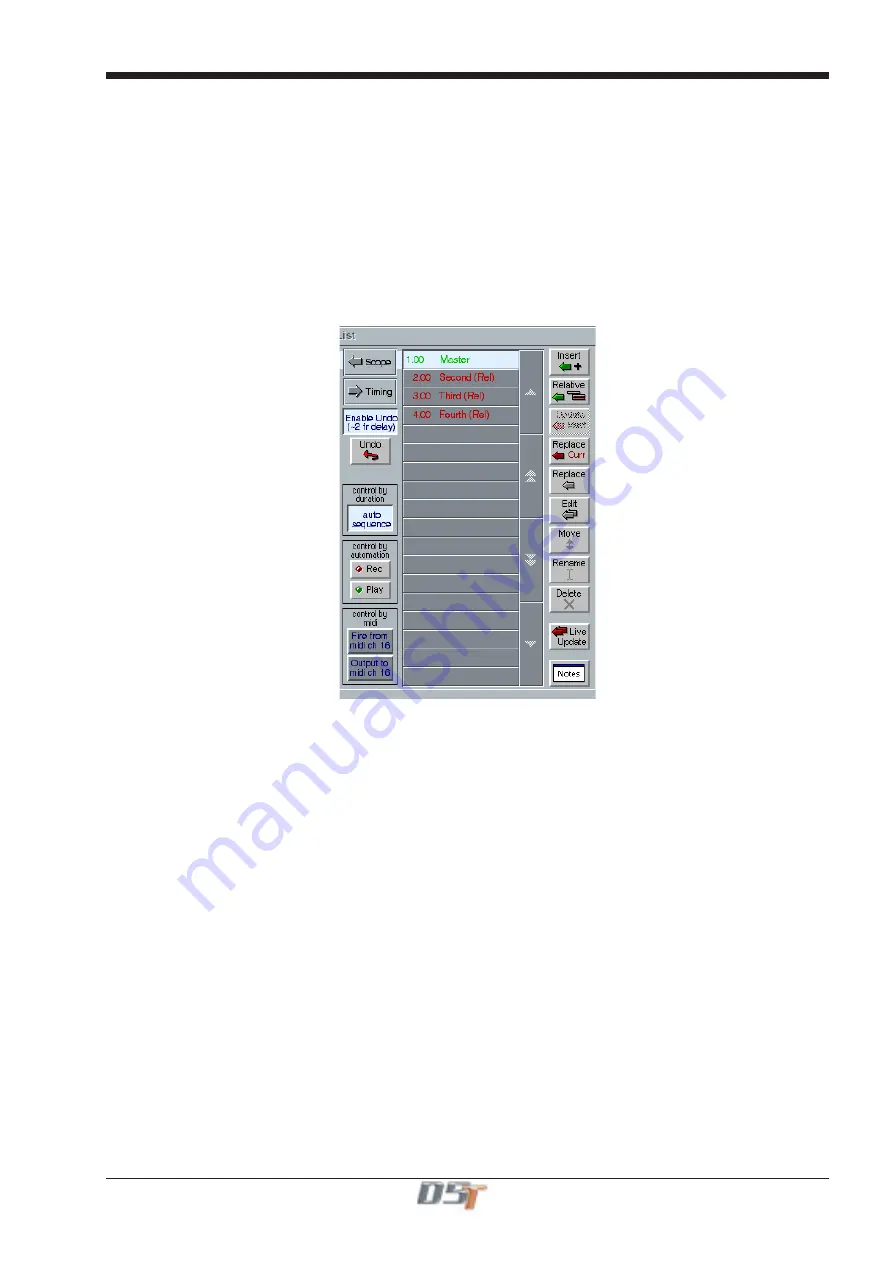
Chapter 6
6-7
6.1.10 Cue Automation .................................................................
The cues can be integrated into the automation system to allow control of non-dynamically automated parameters, or simply to allow
instant changes for the entire console which are all tied to a single editable event.
For more information on how to store and recall cues see section
5.1.
You can use Cues in conjunction with the Automation system in two ways -
1)
By firing the Cue with the channels in record mode. This is an easy way of entering control changes for a large number of channels
simultaneously. To use this method, put the channels into Record/Update, and the Cues into Isolate.
2)
By recording the firing of the Cue. This automates the replaying of the Cue, rather than recording the data in the Cue into each
channel's automation. To use this mode, put the channels into Isolate, and the Cues into Record.
The first method does not automate the cue itself, and its use is identical to normal dynamic automation as described earlier. The rest of
this section is devoted to the second method.
Automating the Firing of Cues
To allow the second of these options, the Cue control panel on the Master screen has its own Rec and Play buttons and LEDs:
To record the firing of a cue at a certain time, touch the Record button in the Cues panel, run the timecode and press the cue buttons. The
cues will be replayed at the same timecode, and the labels for the cues will be inserted in the Cue line at the top of the Automation Editor.
(See section 6.2 for more information about the Automation Editor.)
Cue Update Mode
Note that Cues are not affected by the Touch Record / Relative Update, or Auto-Null settings. If the Cue Play light is on, Cues will only
replay. If the Cue Record light is on, Cue firings will be recorded, and old ones overwritten - in other words, if the timecode rolls over an
existing cue firing, this firing will be deleted even if nothing new is recorded.
If cues are in Play and you press Rec, both lights will stay on, indicating that Cues are now operating in Update mode. Any existing cues
will be replayed and any new cue firings will be added. Nothing will be erased.
To edit the timing of cues, use the timeline (
see 6.2 Automation Editor
).
Combining Cues and Dynamic Automation
You will have noticed that the Cue Mode buttons and the channel mode buttons are completely independent - changing either does not
affect the other.
Note also that, by default, the channel automation mode buttons control the automation mode for all the channel controls. You can,
however, set the automation mode for each control individually using the Automation Editor screen.
This gives a wide range of possibilities for combining Cue and dynamic automation - here are a few examples:
Cue only - all channels in Isolate and cues in Play or Update.
In this mode all parameters will be affected by the cues which are replayed. You can move channel controls manually, and they will remain
as set until the next cue fires.
All Channel Controls and Cues in Play
:
Any control which is dynamically automated is automatically locked out from the cues. This means that when a cue fires, a fader in play
will not move to the position which was stored for it in the cue but will remain at the level the dynamic automation dictates. Controls which
are not dynamic (compressor attack, release etc.)
will
change however.
Channel Faders in Play, EQ controls in Trim, Cues Isolated:
Faders will move dynamically as normal but ignore cues. Manually pressing cues will make and store changes to the EQ controls.
Channel Controls in Record, Cues Isolated
: Firing a cue will reset all controls
including
dynamically automated controls. The result is
that the "contents" of the cue will be instantly inserted in the dynamic automation database. You will see these events on the timeline and
can then edit them on a channel by channel basis.
Summary of Contents for D5T
Page 1: ...Operation Manual Issue A September 2004 Software Versions 2 4...
Page 2: ......
Page 10: ......
Page 11: ...Chapter 1 1 1 Chapter 1 Getting Started...
Page 12: ...Chapter 1 1 2...
Page 32: ...Chapter 2 2 1 Chapter 2 Inputs and Console Channels...
Page 33: ...Chapter 2 2 2...
Page 58: ...Chapter 3 3 1 Chapter 3 Busses and Outputs...
Page 59: ...3 2 Chapter 3...
Page 68: ...4 1 Chapter 4 Chapter 4 Master Section...
Page 69: ...Chapter 4 4 2...
Page 91: ...5 1 Chapter 5 Chapter 5 The Cue List...
Page 92: ...Chapter 5 5 2...
Page 111: ...Chapter 6 6 1 Chapter 6 Automation...
Page 127: ...7 1 Chapter 7 Chapter 7 Effects...
Page 128: ...7 2 Chapter 7...
Page 135: ...8 1 Chapter 8 Chapter 8 Troubleshooting...
Page 136: ...Chapter 8 8 2...
Page 139: ...A 1 AppendixA Appendix A D5TC Theatre Masters Controller...
Page 140: ...A 2 Appendix A...
Page 147: ...B 1 Appendix B Appendix B Multiple Console Setups Inc Redundant Engines...
Page 148: ...B 2 Appendix B...
Page 162: ...B 16 Appendix B Standalone PC Screen Appearance...






























